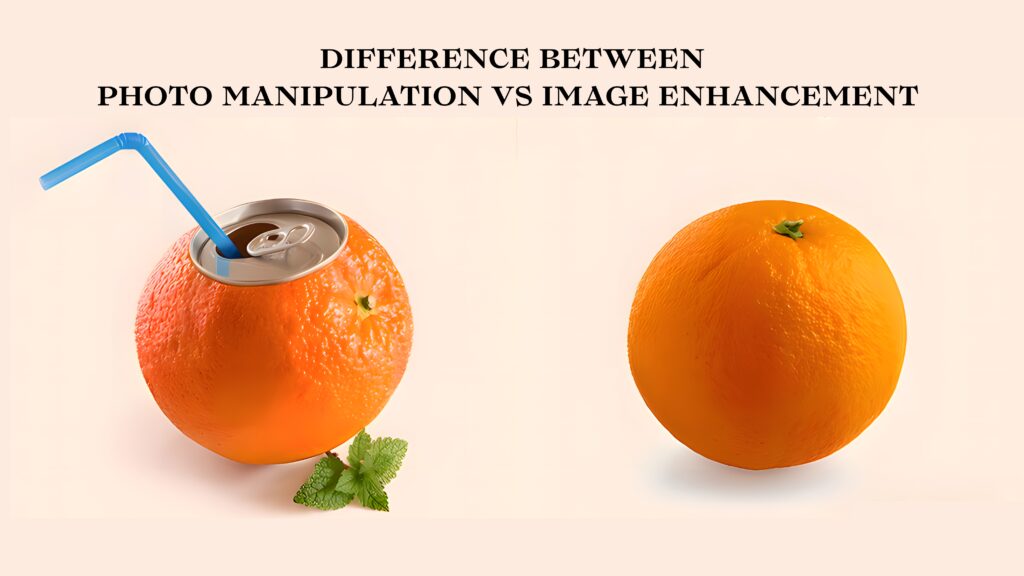In the world of digital design and visual marketing, the terms “image enhancement” and “image manipulation” are often used interchangeably but they’re not the same. Understanding the difference between the two is essential for businesses, photographers, designers, and e-commerce brands who rely on high impact visuals to succeed.

What Is Image Enhancement?
Image enhancement refers to improving the quality of a photo without altering the content. It aims to present the subject more clearly, cleanly, or beautifully but truthfully. The goal is to highlight existing features while keeping the image authentic.
Common Image Enhancement Techniques:
- Brightness and contrast adjustment
- Sharpening details and textures
- Noise reduction and smoothing
- Color correction and tone balancing
- Shadow and highlight recovery
Use Cases: Product photography, real estate listings, professional portraits, and catalog shoots where realism is key.
What Is Image Manipulation?
Image manipulation involves creatively altering an image, often beyond what was originally captured. This may include adding or removing elements, changing shapes, or combining multiple photos. While it can produce stunning results, it’s more stylized than realistic.
Common Image Manipulation Techniques:
- Background replacement
- Compositing multiple images
- Shape warping or model slimming
- Removing or inserting objects
- Artistic effects or surreal edits
Use Cases: Advertising, graphic design, editorial covers, fantasy photography, and social media creatives.
Key Differences Between Enhancement and Manipulation
| Aspect | Image Enhancement | Image Manipulation |
|---|---|---|
| Purpose | Improve clarity and realism | Create a new or imaginative reality |
| Ethical Use | Generally accepted in product, real estate, and medical images | Must disclose in advertising, can mislead if not stated |
| Tools Used | Adjustment layers, color grading, clarity tools | Clone stamp, liquify, layer masking, photo compositing |
| Editing Depth | Light to moderate | Heavy and transformative |
When to Use Which?
Choosing between enhancement and manipulation depends on your purpose:
- Use enhancement when you want accuracy, detail, and authenticity.
- Use manipulation when you want to create concepts, visuals, or stylized storytelling.
For example, a fashion brand may enhance clothing images for an online store but manipulate the same visuals for an Instagram ad campaign.
How This Affects Brand Trust
Modern consumers are savvy. Overly manipulated photos can reduce trust especially in e-commerce. That’s why many brands stick to enhancement for product pages, reserving manipulation for social media creatives and promotional campaigns.
At OutsourceImage, We Offer Both Ethically and Expertly
Whether you’re looking for subtle enhancement or creative transformation, our team has years of experience delivering high quality visual content with clarity, consistency, and impact.
Get a Free Quote or Trial Edit Now
What Our Clients Say
“OutsourceImage helped us enhance over 1,000 product photos. They look consistent, clean, and trustworthy. Highly recommended!”
– Ramesh
“Their manipulation work is world-class. We created ad campaigns that really stand out without misleading customers.”
– Tanya
“We appreciate that they explain the ethical difference between manipulation and enhancement very professional.”
– Vivek Sharma
Conclusion
Image enhancement and image manipulation serve different purposes both are powerful, but must be used wisely. While enhancement polishes what’s already there, manipulation creates something new. Knowing when and how to apply these methods can dramatically improve the impact of your visual content.
Let OutsourceImage help you choose the right approach for your goals whether that means realistic touch ups or artistic transformations.


